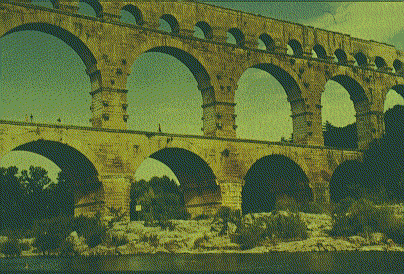
ESDEP WG 1B
STEEL CONSTRUCTION:
INTRODUCTION TO DESIGN
To review the development of steel bridge construction, demonstrating how improvements in methods and understanding of structural behaviour have enabled greater efficiency and longer spans.
None.
Lecture 1B.4.1: Historical Development of Iron and Steel in Structures
Lecture 1B.4.2: Historical Development of Steelwork Design
Lecture 1B.4.3: Historical Development of Iron and Steel in Buildings
The historical development of bridges throughout the world is used to illustrate developments in structural engineering. Three categories of bridges are considered - arches, beam structures and suspension bridges. The precedence of masonry and timber construction are considered briefly, showing how these older forms have become adapted to take advantage of the characteristics of firstly iron and then steel. Significant technical innovations concerning materials, analytical methods and design concepts are highlighted. Some notable failures, and the lessons to be learned from them, are discussed.
The historical development of bridges is the field which best illustrates the progress of structural engineering from ancient times up to the present century. In particular the development in steel bridges equates with the progress in structural analysis, theory of strength of materials and materials testing, since all of them were increasingly stimulated by the need for bridging larger spans and building more economically with the new construction method. Fortuitously, mechanics and mathematics had reached the threshold of modern engineering science just when the technology of constructional steelwork was being developed.
However, at the time when the new material, iron, and later steel, was ready for use in larger structures there already existed a quite highly developed technology in bridge building, namely for bridges in timber and bridges in stone. During the years 1750 - 1770 approximately, a new method of coke smelting produced larger amounts of iron at a cost which provided the basis for application of iron in engineering practice.
It is important to mention that the technologies of bridge building at that time were based on individual intuition of outstanding "masters" and on the experience passed down through the generations rather than on rules of mechanics and mathematics. The significance of preserving the knowledge of bridge building and of extending it was closely connected with military purposes and the interests of trade in ancient times. The Romans even established a separate caste - the "pontifices" (bridge makers) - who later were raised into the rank of priests, headed by the "pontifex maximum", which was also one of the titles of the Roman emperors. Similar reasons motivated the French kings, e.g. Louis XIV, and later Napoleon, to support the new engineering schools (Ecole de Ponts et Chaussés and Ecole Polytechnique).
Thus, the building of steel bridges was founded at the beginning on the then well-tried principles and construction methods of timber and stone bridges. Stone bridges provided the arch type while wooden bridges demonstrated mainly fine-structured trusses. According to the typical material properties of cast iron -the first type of iron available - iron bridges were first built as arches. Later, when steel was available, which is capable of acting in tension, various structural systems were developed on the basis of the principles of wooden trusses. Due to the superior material properties of steel and the advantages of the new construction method, a rapid development of bridge structures led to a large variety of efficient, inventive systems for any kind of span.
In this Lecture, the history of steel bridges is subdivided according to three types of bridge:
There is, of course, much overlap in chronological order concerning the three types of bridge through the period of time considered. However, this classification seems to be most appropriate to an engineer's understanding, being based on the main bearing behaviour of bridges rather than on aspects of shape or statical system.
Arches transfer distributed vertical loads to the foundation mainly by compression. Due to the specific material properties of masonry they are basically the appropriate form of structure for stone bridges.
Such arch bridges are known to have existed in the Hellenistic period of Asia Minor. However, they reached their "flowering period" in Roman times, when the typical arch-type aqueducts were extensively used all over the Roman empire, e.g. the "Pont du Gard" near Nimes in Southern France, built in 18 B.C. (Slide 50). Up to that time arch bridges were formed in the semi-circular shape only, which did not allow spans greater than about 35 to 40 m.

Slide 50
In the Middle Ages the construction of flat arches was developed in order to build lighter bridges and larger spans. Later on, particularly in the newly founded engineering academies of France, this construction method was cultivated by using experience as well as mathematical aids. J.R. Perronet was the master of masonry bridges of that type, e.g. the "Pont de la Concorde" in Paris of 1791 (Slide 51). The technical basis for the application of iron in bridge building was therefore in place.
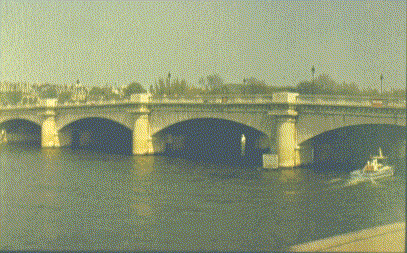
Slide 51
In 1779 Abraham Darby III, an English iron founder, succeeded in building the first iron bridge in Coalbrookdale. Some earlier attempts in France and England had failed because the cast iron of the time which had low tensile and flexural tensile strength, and was also brittle, had been used with inappropriate structural systems. The Coalbrookdale Bridge was constructed as an arch bridge like the examples in stone before, however, the arch was structured in 5 light ribs following the constructional principles of wooden structures. The bridge has a span of about 30 m and is still in use. Such cast iron bridges soon became common structures in Britain and were exported to other countries (Slide 52).
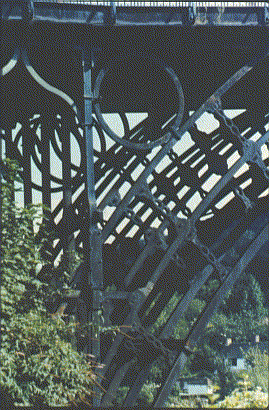
Slide 52
In the following years, iron casting was developed to supply different bridge building methods. Pre-fabricated, block-shaped elements were used like large "bricks" in patented iron arch bridges. The largest of these was the "Sunderland Bridge", built in England in 1796 with a span of 72 m.
Another method was developed by the German engineer Reichenbach, who used cast iron tubes for the compression member of the arch. This economical system was widely used, an excellent example being the "Pont du Caroussel" in Paris, which was built by Polonceau in 1839 with three spans of 48m each (Slide 53).
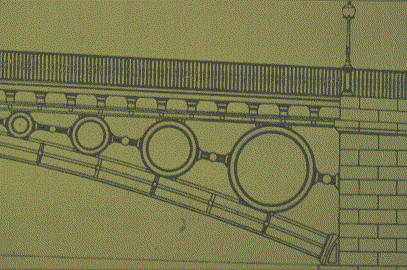
Slide 53
The largest cast iron arch ever built was the "Southwark Bridge" by John Rennie over the Thames in London (1819) with a span of 73 m (Slide 54).
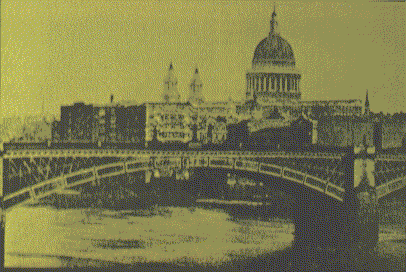
Slide 54
A similar bridge, notable for its marvellous latticed design and the great name of Thomas Telford connected with it, had been built some years previously (1812) in Scotland with a span of 50 m. Other arch bridges of the same typical design were built later and can be found in many places, e.g. over the River Rhine in Germany or over the River Loire in France.
Thomas Telford (1757 - 1834) - originally being a mason - became one of the most notable engineers of his time. After educating himself in architecture he built 3 bridges over the River Severn, after which he worked for the canal companies, building about 900 miles of road and two gigantic aqueducts to carry the canals over valleys. Between 1819 and 1826 Telford built the two famous chain suspension bridges over the Menai Straits and the River Conway. Telford was made the first President of the Institution of Civil Engineers when it was founded in 1828.
The "Mississippi Bridge" in St. Louis was built in 1874 by J.B. Eads (Slide 55). He used tubular members partly of iron and partly of steel to form the latticed arch of 159 m in span. It was the first bridge he built and surprisingly became the largest arch span in the world.
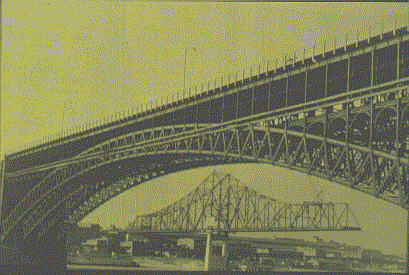
Slide 55
Steel arch bridges cannot be discussed without appreciating the contribution of Gustave Eiffel, one of the greatest engineers of his century. Eiffel (1832 -1923) founded and led the "Société Eiffel", an engineering and steel fabricating company, well known throughout the world, with agencies in the Middle East, Eastern Asia and South America. Its main field of production was various kinds of steel bridges, of which the arch bridges were the most important. Eiffel also used trussed construction. He was the first engineer to develop the preparation of steelwork design up to full detailing and drawing of every element or single rivet. His first big success was the railway bridge over the Duoro in Portugal (1878) with an arch span of 160 m. His most beautiful bridge was the "Viaduc de Garabit" in the South of France, built in 1884 with a span of 165 m (Slide 56). The buildings which made him most famous are the 300 m high "Eiffel Tower" (1889) and the "Statue of Liberty" (1886).
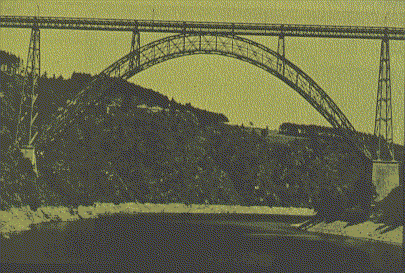
Slide 56
With the development of steel the size of structures increased. The largest arch spans were built in the years up to 1930:
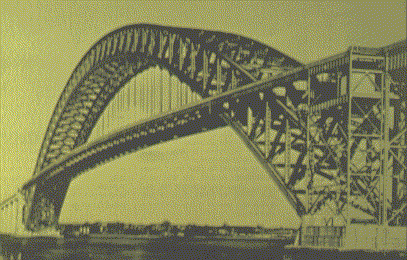
Slide 57
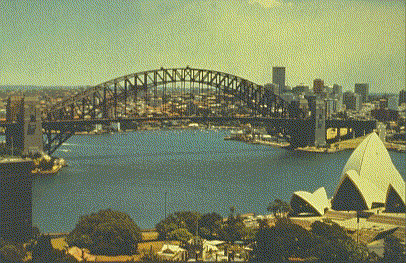
Slide 58
Both bridges are two-hinged trussed arches with the deck suspended.
It was indicated at the beginning of the section "Arch Bridges" that iron in the first period of bridge building could only be used in compression. It was not until more than fifty years later when larger bridge structures were built that bending structures were adopted using the newly developed wrought iron, and later steel, which were capable of acting in tension as well. At that time there already existed a highly developed technology of building such bridges in timber, in particular trusses of various shapes and systems. Since constructional steelwork at the start used a great deal of this knowledge a short overview is given below of the development of wooden bridges.
Wooden bridge structures
In Roman times (during the reigns of Caesar and Trajan) individual wooden bridges of impressive dimensions were built over the River Rhine and the Danube. Wooden bridges then became very common in the Middle Ages, although few of them have survived. The first methodical studies of statical systems were performed by the Italian architect Andrea Palladio (+ 1580), demonstrating different types of trusses and strutted frames, which were then called "Palladian bridges".
The heyday of bridge building in timber took place in the second half of the 18th century, when individual master builders like Grubenmann and Ritter in Switzerland, Gauthey in France and Wiebeking in Germany developed outstanding structures with spans up to 100 m. From that time on the development of wooden bridges moved to the USA, where - due to the lack of trained carpenters - simplified structures came into use. Standardized and prefabricated elements and simple connections were made with unskilled labour, but nevertheless produced large bridge structures, especially for the railways. The main types of bridges resulting were trestle bridges (Slide 59) and truss bridges.
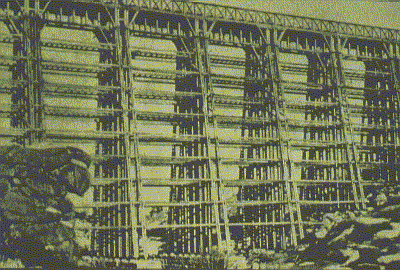
Slide 59
The latter - among others - comprised patented systems like the widely used crosswise-pretensioned truss girder by Town (Slide 60). Many of the structural ideas were transferred to trussed steel bridges at the beginning. Due to the superior material behaviour of steel, wooden bridges were replaced step by step up to the end of the 19th century.

Slide 60
During the first half of the 19th century, steel bridges were frequently designed as trusses, particularly in the USA. This was mainly due to their economical load-carrying behaviour. However, in Europe this same development was interrupted by a short period, when tubular bridges were made of large plated girders.
Development of plated girders - Robert Stephenson
When in 1844 the Chester & Holyhead Railway Company decided to build a railway line from London to the Isle of Anglesey in Northern Wales, two big obstacles had to be bridged, namely the Menai Street and the River Conway. Robert Stephenson (1803 -1859), the son of the great George Stephenson, was in charge of the project. He, in contrast to his father who had been self-taught, was well educated. He became leader of his father's locomotive factory at the age of twenty-seven and was at that time well renowned as a railway and bridge engineer in Britain.
After several studies of bridging the Menai Strait with an arch bridge or using a chain suspension bridge, which Thomas Telford had built about 20 years previously in the same place for the railway, Stephenson decided to build a bridge in the shape of two rectangular tubes (each 4,4 m wide and 9 m deep) through which the two railway tracks ran (Slide 61 and 62). He performed the design on the basis of extensive experimentation on models in the scale 1 : 6 with circular, elliptic or rectangular cross-section. The research was done in a team together with W. Fairbairn, responsible for the testing, and E.Hodgkinson, performing the theoretical work. It showed that the closely stiffened plate-girders made of wrought iron combined with the cellular upper and lower deck construction were strong enough to carry the load over the spans of 142 m without additional support by stays from the top of the piers. Such stays had originally been provided when erecting the towers, which then gave the bridge its unique appearance.
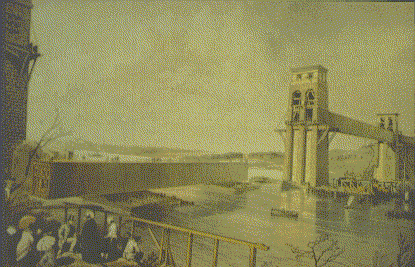
Slide 61
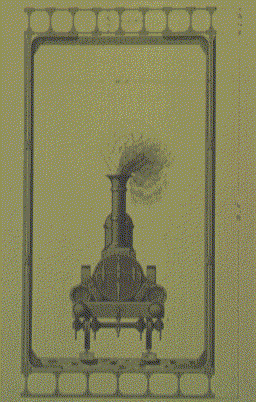
Slide 62
The bridge, which consisted of 4 spans of 70 + 142 + 142 + 70 m, used 10.600 tons of iron and incorporated 3,5 million rivets. It was fabricated near the site in equal pieces for each single span, and each of them was floated to the site and lifted to its final position. Both fabrication and erection were masterpieces. When the "Britannia Bridge" as it was known, was opened in 1850, Stephenson could not have known how much he had contributed to the development of plate girder construction. It was about 90 years before plate girder bridges of similar spans could be built again. The Britannia bridge carried the railway traffic well for 120 years until 1970 when it was damaged by a fire.
A second bridge of this type, but with somewhat smaller spans, was built by Stephenson over the River Conway at the same time.
Truss bridges (parallel girders)
As already mentioned the building of steel truss bridges was highly influenced by the examples of wooden trusses, built using various systems in the USA. In the first period especially, when only flat members were available, the latticed girders by Town were copied in steel, resulting in fine-mesh lattice girders since flat sections can resist compression forces only with reduced buckling length. Nevertheless, the lattice girders showed good statical behaviour and soon were built with considerable spans.
The largest beam bridge of this type in Europe, the "Dirschau Bridge" over the River Weichsel (Vistula) in Germany, was completed in 1857 (Slide 63). The single-track railway bridge was built by the great bridge engineer Karl Lentze (1801 - 1883) with six spans of 131 m each, using closely spaced lattice girders. His design was largely influenced by the Britannia bridge, showing a similar tubular cross-section as well as similar tower-like pillars. This bridge moreover shows a "speciality" of some Germany bridges, i.e. a castle-like entrance building, which was sometimes ironically criticized in other countries. Nevertheless, considerable economies in the use of steel resulted, the Dirschau bridge needing 8,3 tons of iron per metre compared with the 12,5 tons of the Britannia bridge.
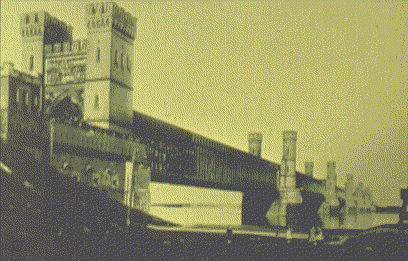
Slide 63
The first iron truss bridge to be made of struts was the "Grandfey Viaduct" near Fribourg in Switzerland, opened in 1862 (Slide 64). Although similar in type to the wooden trestle viaducts in the USA (see Slide 59), it was the first true modern trussed girder with appropriate compressive members. The bridge had seven spans of 49 m and was erected by launching the girder over the high steel piers.
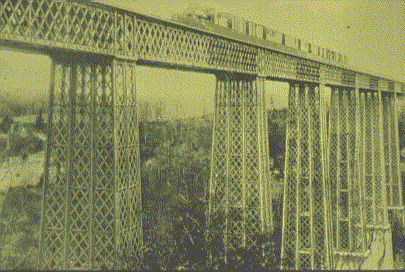
Slide 64
Further progress in building truss girders was encouraged by new methods of structural analysis. Karl Culmann (1821 - 1881), then a young German engineer, was sent to the USA in 1849 by the Royal Bavarian Government in order to report on the novel wooden and iron bridge types which he found there. His studies led to the development of graphic methods of structural analysis, which he published by 1860, when he was professor at the ETH Zurich. From that time a full theory existed for the design of trusses.
A typical truss bridge of that time was the Danube Bridge near Stadlau in Vienna. It was built in 1870 as a continuous beam with five spans of 80 m each. The picture (Slide 65) shows the process of launching.
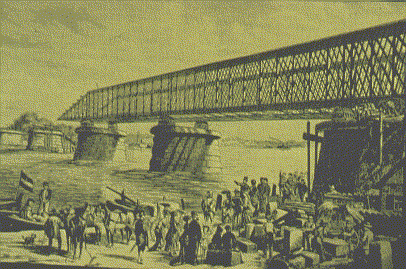
Slide 65
Building truss girders was developed to perfection by G. Eiffel - as already described in the section "Arch bridges". Eiffel built a great number of truss bridges for the railway in France and Portugal; an example (Slide 66) is taken from the Beira-Alta line (1879 - 1881) in Portugal. Eiffel's largest bridge of this type was the bridge over the Tardes near Evaux, with a main span of 105 m (72 + 105 + 72 m), built in the same period.
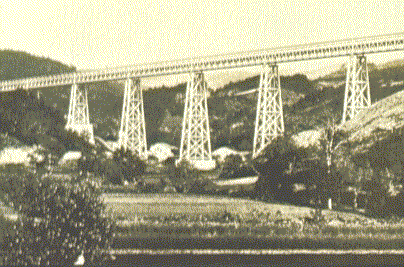
Slide 66
Truss bridges of the parallel-girder type were built in great variety, especially for the railways in Europe, with a tendency towards simpler statical systems, e.g. the triangular truss. The Rhine Bridge near Maxau in Germany, built in 1938, is a good example (Slide 67). It is a combined railway/road bridge with spans of 175m and 117m.
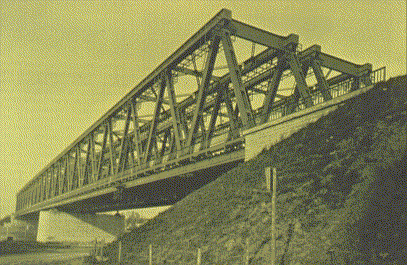
Slide 67
Pauli girder, Saltash Bridge, Lohse girder
(fish-belly or parabolic girders)
The objective of obtaining an optimum distribution of the chord forces in trusses led to new shapes of girders, the parabolic-truss girder with a curved upper chord and the fish-belly type girder with both chords curved in opposite directions. The latter, called the "Pauli girder" in Germany, turned out to be very economical with chord forces being approximately constant along the length of the bridge. This system was developed by Friedrich August von Pauli (1802 - 1883), a railway engineer of the Royal Bavarian Government and later Professor at the Technical University of Munich.
The first Pauli girder, built in 1857, was the railway bridge over the Isar near Grob hesselohe (Germany) with spans of 53 m (Slide 68). It was built under the direction of the young Heinrich Gerber (1832 - 1912), who afterwards became one of the great bridge engineers in Germany. Gerber contributed much to the design and analysis of the Pauli girder. However, his wide reputation resulted from the development of the cantilever bridge.
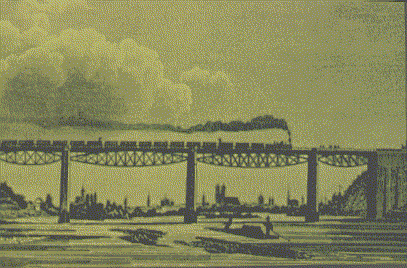
Slide 68
In order to summarize the great German bridge engineers of the 19th century also Johann Wilhelm Schwedler (1832 - 1912) has also to be mentioned. He contributed much to the progress of German constructional steelwork. One of his ideas was a specific parabolic truss girder, frequently used in Germany and called the "Schwedler Girder", which was designed so that none of the diagonals would be subjected to compression.
A gigantic bridge of the fish-belly type was the "Saltash Railway Bridge" near Plymouth, also known as the "Royal Albert Bridge" (Slides 69 and 70). Completed in 1859 and having two spans of 139 m each, the Saltash Bridge had a tubular upper chord with a high elliptic cross-section (5,2 m ´ 3,7 m), made of riveted curved plates, and a lower chord consisting of chains. Constructional difficulties prevented this type of bridge being built again. The builder was Isambard Kingdom Brunel (1806 - 1859), a renowned railway engineer in Britain and one of the most ingenious engineers of his time, whose father built the first tunnel below the River Thames in London. Brunel, after finishing his studies in France, became assistant engineer on the project of the Thames Tunnel. Although he also later built two chain suspension bridges, his greatest railway work was the Royal Albert Bridge. Brunel also designed both the first and the largest steam ships for transatlantic voyages and was also involved in the construction of many docks, piers and hospitals.
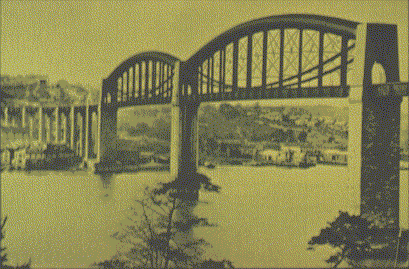
Slide 69

Slide 70
Fish-belly type girders of Pauli's design had a lot of constructional advantages and were used in German bridges again and again. For example the second "Dirschau Bridge" over the River Vistula built by J.W. Schwedler in 1891 had six spans of 131 m. The amount of structural steel used for the new bridge which carried two railway tracks, was the same as for the first bridge built in 1857 having only a single track (Slide 71).
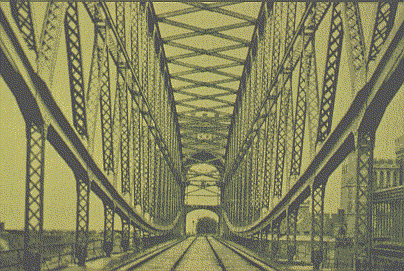
Slide 71
A similar type of bridge was the double bow girder bridge, called "Lohse Girder" after its originator, the German bridge engineer Hermann Lohse. The structural system, somewhere in between the fish-belly type and the tied-arch type, consisted of two trussed chords connected with vertical members. The most important examples are the five Elbe Bridges near Hamburg built in the period from 1872 - 1892; one railway bridge over the Southern Elbe and a road bridge and three railway bridges over the Northern Elbe. All are of similar shape, having three or four spans of about 100 m each (Slides 72 and 73) and, again, the large entrance buildings typical for that time.
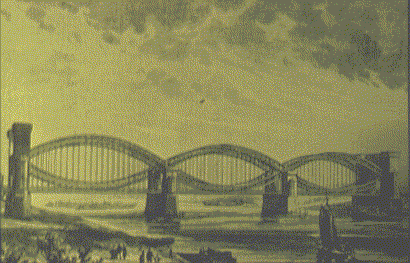
Slide 72
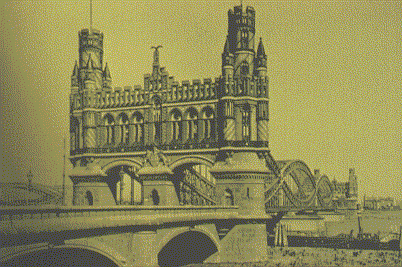
Slide 73
Parabolic truss systems were also widely used, particularly for railway bridges across the large rivers in Germany. The "Lek Bridge" near Culenborg in the Netherlands had the longest span of such girders for a long time. It was built in 1868, using steel for the first time in bridges, by the German engineer and fabricator J. Caspar Harkort. The truss had a span of 155 m and a depth at midspan of 20,5 m (Slide 74).
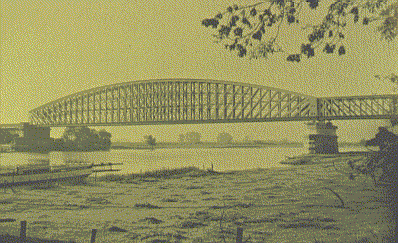
Slide 74
Cantilever bridges, Gerber beams
Nearly all bridges of the first half of the 19th century were single span beams, which means that multi-span bridges were divided into single spans on the piers. Of course, engineers of that time were aware of the beneficial statical behaviour of the continuous beam. However, they knew also of the disadvantages in relation to foundation settlements. It was the idea of the German H.Gerber to introduce hinges into continuous beams at statically favourable locations, which eliminated the drawbacks of settlements. This idea was patented in 1868 and such beams were called "Gerber beams".
Heinrich Gerber (1832 - 1912) was one of the most important bridge engineers in Germany. After his time in the Royal Bavarian Railway Authority he became the head of a significant German steelwork company and contributed much to the development of steel bridges. He was the first to introduce Wöhlers design principles for fatigue in railway bridge construction.
A special type of truss structure following Gerber's principle of hinged beams is the cantilever bridge. By making the truss girder deeper at the piers, cantilevers may be built far into the middle of the span without the need for any centring (falsework). This technique is of great importance when bridging deep or rough water.
One of the greatest cantilever bridges is the "Firth of Forth Bridge" in Scotland. When built in 1883 - 1890 with main spans of 521 m, it gained the world record for the longest span bridge (Slide 75). Some historical background of the specific design realised by the two engineers Sir John Fowler (1817 - 1898) and his partner Benjamin Baker (1840 - 1907) is given below.

Slide 75
When construction of the bridge was about to start, the design was that made by Sir Thomas Bouch, a renowned bridge engineer, who had just finished the railway bridge over the Firth of Tay with a total length of 3200 m. This was a multiple-span truss bridge with main spans of 75 m, which collapsed in a heavy storm on 27 December 1879 just when a train was crossing, causing the death of 72 people (the German poet Theodore Fontane wrote a famous poem about this accident). As a result, Thomas Bouch lost all credibility with the railway company, his successors, J Fowler and B Baker, having to illustrate the statical principles of their design to the public (Slide 76).
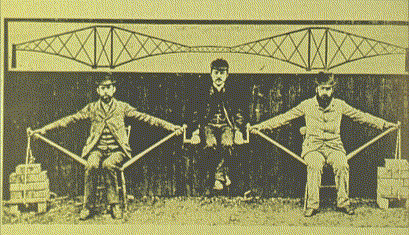
Slide 76
The bridge, which today is considered to be a unique and gigantic construction, is a masterpiece of engineering work. The depth of the truss above the piers is 106 m, the main tubular members are 3,7 m in diameter, and the whole bridge used 42.000 tons of steel and at times required up to 4.600 workers at the site to undertake the complex method of construction (Slide 77).
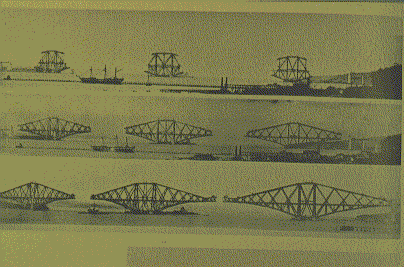
Slide 77
J Fowler was a notable civil engineer, mainly involved in railway construction. He was a pioneer of the London Underground and later elected President of the Institution of Civil Engineers. Just how much the builders of the Forth Bridge accomplished can be recognized by comparisons with the "St Lawrence Bridge" near Quebec. This cantilever bridge, very similar in type, became the longest hinged beam bridge when built in 1917, with a span of 549 m. However, although only 27 m longer in span than the Forth Bridge, it took 12 years to build, two major failures having occurred during construction, indicating that theoretical and practical limits had been reached.
The "Hooghly River Bridge" in Calcutta, built in 1940 with a span of 455 m, is the fourth largest cantilever bridge (Slide 78). Although a late example of this successful type of bridge, the design seems not to be so clear as that of its predecessors.
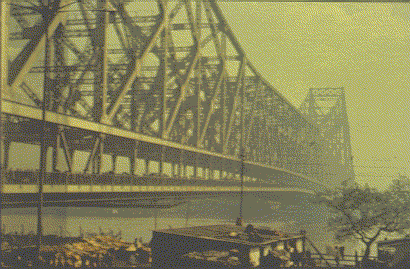
Slide 78
Truss Bridges in the USA
Based on a good tradition of wooden truss bridges, it was Squire Whipple who first developed the method of analysing and designing trusses made of cast and wrought iron. He was called the "Father of iron truss bridges" and built his first bridge in 1841, a bow-string type truss (parabolic girder), which was patented and successfully built many times in the years following. In 1847 he published a book on bridge building and developed the trapezoidal truss bridge, called the "Whipple-truss". Whipple built two of these bridges with spans of about 45 m for railroad use in 1852-54. These bridges have chords with forged wrought iron links, which were in later years modified step-by-step by Linville into eye-bars made of steel and accordingly allowed increased spans. The longest bridge of this type, with a main span of 155 m, was built for the railway in 1876 over the Ohio River near Cincinnati. The longest simple span truss of this time was a bow-string truss with spans of 165 m also over the Ohio River in Cincinnati, built by Bouscaren in 1888.
There were also cantilever bridges built in the USA during the period 1877 - 1889, which have main spans of 165m. They were erected by use of falsework, e.g. the "High Bridge" across the Kentucky River and the "Hudson River Bridge" at Poughkeepsie.
Plate/Box Girder Bridges
After the exceptional example of the Britannia Bridge, plate girder bridges remained within spans of about 30 m. Fresh impetus was given by the development of welding in constructional steelwork. The use of welding began in about 1925 and considerably influenced the building of steel bridges, particularly road bridges. After setbacks in the 1930's due to brittle fracture failures, a very rapid increase in the size of spans took place. A typical example of large spans is the "Rhine Bridge" in Bonn (1948) with spans of 99 + 196 + 99 m (Slide 79).
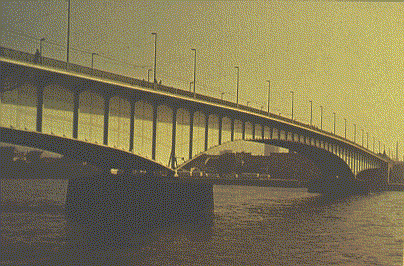
Slide 79
Tied Arches
A tied arch bridge acts like a beam structure, which is assisted in carrying load by an arch behaving similarly to a curved upper chord of a truss, while the deck girder acts like the lower chord. Arch and deck girder are simply connected by hangers and form a structure which has considerable constructional advantages compared to true trusses when bridging wide single spans or carrying heavy loads. Tied arch bridges have been incorporated in this section because their main statical behaviour resembles beams rather than arches, e.g. transmitting vertical reactions to the abutment when subjected to vertical loads.
Such bridges were frequently used in the past, especially for heavy railway bridges. The first long span bridges were built in Hamburg over the Southern Elbe (1899) with four spans of 100 m. In 1906 - 1910 in Cologne the "Hohenzollern Bridge" was built with spans of 102 + 165 + 102 m (Slide 80). When the old Lohse girders in Hamburg had to be replaced (1915) tied arch bridges were also used (Slide 81).
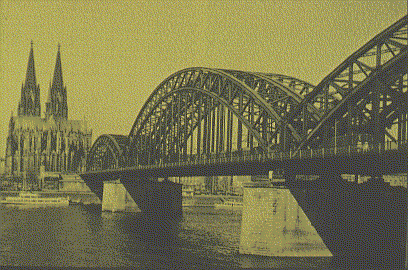
Slide 80
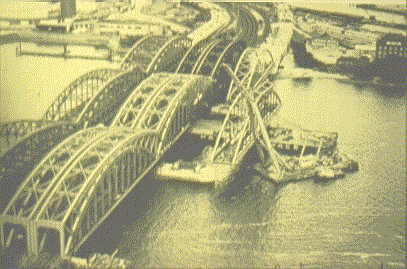
Slide 81
Cable Stayed Bridges
Similarly, to tied arch bridges, cable stayed bridges are classified under the topic of beam structures. They actually behave like elastically supported continuous beams rather than like suspension bridges, although are often considered as being related to them. The cable stays provide a more or less elastic support at individual points along the deck girder. This arrangement allows bridges of considerable span to be built with relatively slender girders. Only vertical reactions are transmitted to the abutments as a result of vertical loading.
The cable stayed bridge was the most recently developed of all the types of bridges. It originated in Germany (about 1950) and the first bridge completed in 1957 was the "Theodor Heuss Bridge" in Düsseldorf (spans of 108 + 260 + 108 m). A great number of such bridges, mainly different in the type of pylon and the cable design, were built along the River Rhine, e.g. the harp-shaped design in Düsseldorf/Oberkassel (Slide 82) or the closely spaced, fan-shaped design in the North of Bonn Bridge (Slide 83).
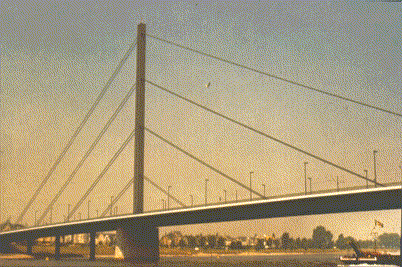
Slide 82
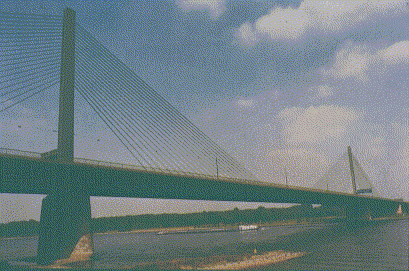
Slide 83
The predecessors of iron and steel suspension bridges were pedestrian bridges made of rope utilising different materials during the early centuries in China, India and South America. Iron chain suspension bridges are of Chinese origin, the oldest known bridges having been built about 500 years ago. None of them were stiffened. They swayed violently under traffic and their thin decks were directly secured onto the chains.
The first proposal for a chain suspension bridge with a horizontal traffic deck suspended from three chains was published by Faustus Verantius (1551 - 1617), a Renaissance scholar, but it was not until the late 18th Century that such bridges were built (Slide 84).
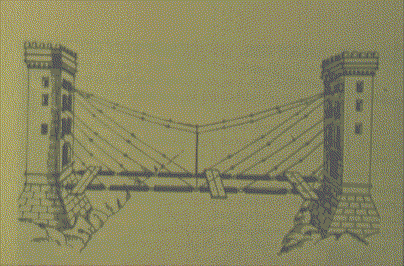
Slide 84
The first of them was built by James Finley (1762 - 1828) in 1796 in the United States, followed by a large number of the same type, Finley having been granted a patent. Finley's bridges were relatively stable and could therefore be used by wheeled traffic.
Chain Suspension Bridges
The first chain bridges in Europe were erected in Great Britain.
In 1819 Samuel Brown (1776 - 1852) built the "Union Bridge" near Berwick with a span of 120 m after having invented a new type of chain, the so-called "Eye-bars". (Following this invention the fabrication of chains moved from the manufacturing of ordinary anchor cable type chains in blacksmiths' shops to wrought iron fabricators).
Brown built further chain bridges, e.g. in 1820/21 the "Trinity Pier Bridge" in Newhaven near Edinburgh (3 chainbridges in a row, each 64 m in span) and in 1822/23 the larger "Chain Pier" in Brighton, which was designed as four chain bridges of 78 m span in line. This bridge suffered from wind-induced vibrations and parts of it were destroyed twice in major storms.
It is interesting to know that, even in 1823, Marc Isambard Brunel (1769 - 1849), the builder of the Thames tunnel in London and father of the great railway engineer I K Brunel, built two chain bridges on the Isle of Réunion which were effectively stiffened against wind by additional counter-curved chains located below the bridge deck.
A milestone in bridge building was the chain bridges built by Thomas Telford, who has already been mentioned in the section on arch bridges.
The Chain Bridge over the Menai Straits in North Wales (Slide 85), being a road bridge with a free span of 177 m, was the bridge with the longest span of the time. Built in 1819 to 1826 (Telford was 60 years old when it was finished), it was an outstanding structure which also influenced Navier when working out his theory on suspension bridges. Telford used eye-bar chains with special improved links. There were 16 chains for each of the two cables. Originally built without stiffening elements it was reinforced during the first year of use after a heavy storm had caused large deflections of about 1 m.
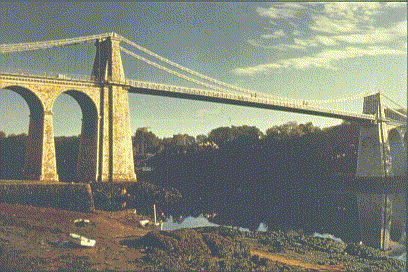
Slide 85
A similar bridge, but of smaller span, was built by Telford over the River Conway near Conway Castle. It should be mentioned that in the case of both the Menai Straits and the River Conway, famous railway bridges were built by Robert Stephenson, close to those of Telford, about 25 years later.
The name of another great engineer, Isambard Kingdom Brunel (1806 - 1859), is also connected with suspension bridges. Brunel, well known for his Royal Albert Bridge, a tubular-type bridge at Saltash, built the "Clifton Suspension Bridge" near Bristol (Slide 86). This chain bridge with a span of 214 m was not finished before 1864. It used the same chains as the "Hungerford Bridge" (span 206 m) in London, which had been built by Brunel in 1845.
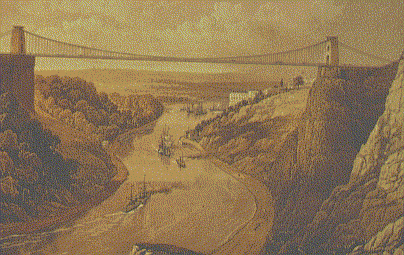
Slide 86
Another British engineer, W T Clark, built chain bridges during this period, e.g. the "Hammersmith Bridge" in London (1827, span 122 m) and the bridge across the Danube in Budapest (1845, span 203 m).
The oldest suspension bridge in Germany was the chain bridge in Malapane (Schlesien), built in 1827 with a span of 31 m. It was followed in 1829 by the "Ludwigs Bridge" across the Regnitz in Bamberg with a free span of 64 m. This carefully designed bridge is of some interest, since it made a deep impression on the young Johann Roebling when he was studying in Berlin. In later years he became the most important suspension bridge engineer.
Further old chain bridges, which are not referred to here in detail, were built in France, e.g. in Paris across the Seine by De Verges (1829, span 68 m) and in Langon over the Garronne by P D Martin (1831, span 80 m). Chain bridges were also built by the Czech B Schnirch in Prague (1842, span 133 m) and in Vienna (1859, span 83m).
Wire Cable Suspension Bridges
Whilst the building of chain bridges continued in Great Britain and Germany, in France, Switzerland and America wire cables began to be used, based on the experience that wires have considerably higher strength than iron chains. Following trial structures built by the French Séguin brothers, the Swiss engineer G H Dufour (1787 - 1875) and Marc Séguin (1786 - 1875) built the first wire cable suspension bridge in the world. This bridge, the "Pont St. Antoine" situated in Geneva, was, when completed in 1823, also the first permanent suspension bridge on the European continent. Six cables of 90 wires each supported the two 40 m spans.
The main problem in the manufacture of parallel wire cables is to guarantee that all wires carry the same amount of tension. While Séguin, being more an entrepreneur than an engineer, tried to achieve this by using cables of different curvatures, Dufour solved the problem by prestressing all wires so that none remained slack. This meant prestressing the cables in a special device and lifting them afterwards onto the saddles. The best solution, i.e. spinning the cables in situ wire by wire was first suggested by the French engineer L J Vicat and developed as a mechanized spinning method by J Roebling.
Although Séguin founded a bridge construction company and built more than 80 suspension bridges of about 100 m in span, the most important example of this generation of wire cable bridges was completed in 1834 by the French engineer J Chaley (1795 - 1861) in Gribourg, Switzerland. It crosses the Saane Valley in a single span of 273 m. It was called "Grand Pont Suspendu" (Slide 87) and was the longest bridge in the world until the "Ohio Bridge" in Wheeling was opened in 1849. Chaley provided 4 cables, each with 1056 wires, and prestressed them like Dufour had done before him. The cables were layed out on the bottom of the valley and lifted up to the top of the towers.
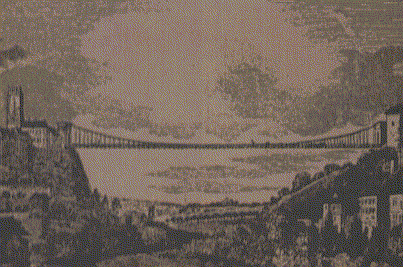
Slide 87
An interesting design was realized with a 'row' of suspension bridges crossing the Dordogne near Cubzac (Slide 88). This consisted of 5 spans, each 109 m in span, having, in addition to the main cables, separate stays which are secured on the top of a tower and land on the next tower at the height of the traffic deck. This bridge was completed in 1839 and was built by de Verges and Emil Martin.
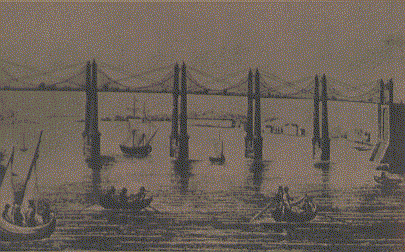
Slide 88
After this period further development of large suspension bridges moved from Europe to the United States, partly due to the expansion of the railway to the west of the country, and also thanks to the emigration of European engineers to America and the transfer of technical knowledge. Two names dominated the major progress of this time, namely Ellet and Roebling. Whilst Ellet is thought of as a rather efficient engineer and clever entrepreneur, the Roeblings, both father and son, with their excellent scientific knowledge and technical skills, gave a major impetus to the art of building suspension bridges.
Charles Ellet (born 1810), being of poor origin, was an example of a self-made engineer. After working as assistant engineer and saving money he decided to study in Europe at the Ecole Polytechnique in Paris. He completed his studies successfully and after that travelled throughout France, Great Britain and Germany visiting the newest bridges and engineering works. On returning to the United States he became very active as an entrepreneur, working on projects for large suspension bridges and proposing them efficiently. During this time he came in contact with J A Roebling, who suggested cooperation, but was rejected, this being the beginning of their subsequent rivalry for life.
After building a number of successful bridges, the biggest success of Ellet was the suspension bridge over the Ohio near Wheeling. Finished in 1849 with a free span of 308m it was the longest bridge of that time. The two cables consisted of 6 ropes each, each of them comprising 550 wires, grouped side by side so that, if strengthening the bridge became necessary for railway operation, further ropes could be added. Before it could be demolished (having insufficient clearance for steamboats), it was destroyed in 1855 in a heavy storm. Six years later it was rebuilt by Roebling.
Railway Suspension Bridges
Before discussing the Roeblings in detail, some remarks should be made concerning the use of suspension bridges for railways. The first attempt was made in 1830 by building a chain bridge over the River Tees near Stockton for an extension of the Stockton-Darlington line. The free span was 86 m, the calculated live load 150 tons, but disappointingly under less than half of the load the deflections were intolerably high. This behaviour accounted for the ill repute of such bridges for bridging railways. However, the suspension bridge engineers in the United States, like Ellet and Roebling, were optimistic or even convinced that suspension bridges for railways could be achieved. Their first major test came with the crossing of the Niagara gorge (see below). Following this, the Brooklyn Bridge was also designed to carry railways. Very few railway suspension bridges have been built since then. An exception was the railway chain bridge built in Vienna by Schnirch across the Danube canal with a span of 83 m (1859).
The Roeblings
The main development of suspension bridges up until the work of the Roeblings had been carried out by British and French engineers. Johann August Roebling (1806 - 1869) was born in Thüringen, Germany, studied at the then famous engineering school, the "Royal Polytechnic Institute" in Berlin, and emigrated in 1831 to the United States. There he became one of the greatest bridge building engineers of that continent as well as the leading fabricator of wire rope. Working first as a surveyor for canal companies he invented machines for manufacturing ropes from wires and then developed an efficient wire rope firm, which later, under the management of his sons, had 8000 employees. Between 1844 and 1850 he built 5 Cabak crossings over Rivers, i.e. aqueducts, as well as one road bridge which were all supported by wire cables. These aqueducts, carrying the high mass of water of the canal in wooden troughs made him a notable engineer. Some of them are still in use even today after having been converted into road bridges.
He developed a mechanized cable spinning method in which wires were carried by a wheel back and forth over the towers and anchorages. Using this method the requirement that all wires should be under the same amount of tension could be realized in a natural way giving every wire the same curvature (sag). Modern methods of manufacturing suspension cables are, in principle, still the same. Some of the operations executed manually in Roebling's time have since been mechanized.
The idea of a railway crossing the Niagara gorge (Slide 89) near the falls was a great challenge to American and European bridge builders. While European engineers like Samuel Brown and Robert Stephenson thought a free span of 250 m for the load of railway traffic to be too risky or even impossible, the Americans Ellet, Roebling, Serrel and Keefer - all being competitors - applied for the project. The first to be successful in winning the contract was Ellet in 1847, but he only built a temporary pedestrian bridge and failed to realize a railway bridge. The next was Roebling in 1851 and he succeeded, building a double-deck bridge for railway and road traffic. The girder was a wooden Howe truss and the four cables consisted of 3640 wires each. When the bridge was opened in 1855, being the first railway bridge of a span of 250m, it made Roebling a very respected engineer. Serrel and Keefer also built suspension bridges across the Niagara, the first one a road bridge (1851 with 318m span, destroyed in 1861 in a storm), the second a footbridge very close to the falls (1868, span 388 m) called the "Honeymoon Bridge", which was also destroyed in a storm in 1889.

Slide 89
The main innovation of Roeblings work was his efficient conceptual design, which allowed for the effect of storms through stiffening by diagonal stays as well as additional stays beneath the roadway. Roebling was also the first to build suspension bridges with systematic rigidity of the deck girder. He published his theories stressing the importance of considering wind effects in the design. It is perhaps surprising that many engineers later forgot the importance of wind effects, culminating in the famous accident at Tacoma Narrows of 1940 (see later).
In the period 1857 - 1866 Roebling built the "Allegheny suspension bridge" in Pittsburgh and then the large "Ohio River Bridge" in Cincinnati with a span of 322 m, which made it the longest in the world when completed in 1866. In this bridge, wrought iron beams and trusses were used for the deck girders. During construction of both bridges Roebling's son, Washington A Roebling (1837-1926), worked as assistant to his father. The Roeblings dream, or even obsession, was to build a bridge over the East River, between Brooklyn and New York. Their idea was for a suspension bridge for railway and road traffic with a span of 486 m. But J A Roebling was not able to realize the project himself due to a mortal accident on site during surveying work, only 3 years after winning the contract. His son took over his position, but during the work in the pneumatic caissons for the foundation of the towers he suffered a serious collapse from caisson disease. From that time on he was an invalid, bound to his bed and suffering from a nervous disorder. He ran the project from his sickroom, located close to the site, watching the progress of the work through a field glass from his window.
His wife, Emily Warren Roebling dedicated her life to the bridge, became his assistant and kept contact with the workers and fellow engineers. When the Brooklyn or East River Bridge (Slides 90 and 91) opened in 1883 it was a masterpiece of engineering work, the largest bridge in the world. The towers, built of masonry, were 107 m in height; the anchor blocks 60.000 tons in weight each; the 4 cables 40cm in diameter, consisting of 5358 wires each; stiffened by a deep trussed deck girder and a large number of diagonal stays.
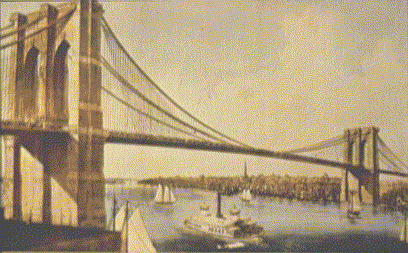
Slide 90
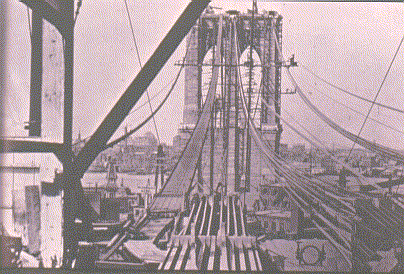
Slide 91
After more than 100 years since it was opened, the Brooklyn Bridge is still in use.
Increasing the Spans
After the Brooklyn bridge, which reached roughly 500m in span, the spans of suspension bridges still continued to increase in size. Fifty years later the previous record span had doubled.
In 1931 the "George Washington Bridge" (Slide 92) in New York was the first structure to span over 1000 m. Othmar H Amman, an emigrated Swiss engineer who became one of the great bridge builders in the United States, used 4 cables of 91 cm diameter and over 20.000 wires each. The bridge carried the greatest live load of any bridge, consisting of two traffic decks and 14 lanes and has a span of 1067 m.
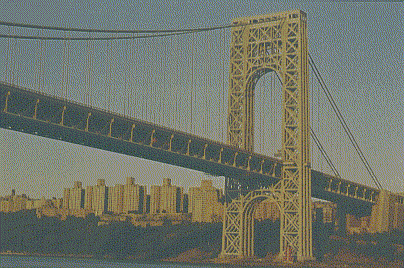
Slide 92
Certainly the most famous of all suspension bridges is the "Golden Gate Bridge" (Slide 93) across the entrance to San Francisco. It was built by Joseph Strauss in 1937 with a span of 1281m. Besides the marvellous shape of the bridge it is interesting to note that the colour of the bridge was carefully selected, resulting in "International orange". Any attempt to change it has been fiercely opposed by the people of San Francisco.

Slide 93
The "Tacoma Narrows Bridge" (Slide 94) near Seattle, with a then average span of 853 m, sadly became renowned when it collapsed in 1940 under wind. The failure was recorded on film. Engineers, dedicated to the opportunities of statical calculations, made continual efforts in building more economical and more slender structures, not being aware of the lectures Roebling had given before on stiffening bridges against wind. The Tacoma bridge was caused to oscillate by wind, although the statical theories - as then known - had been correctly applied. Design methods were revised after this accident and, as a result, new directions developed in the design of suspension bridges:
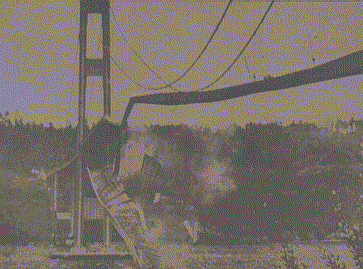
Slide 94

Slide 95
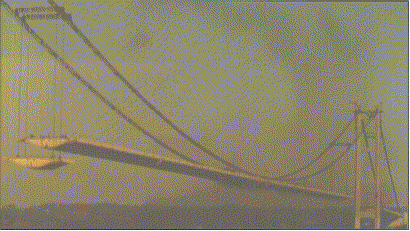
Slide 96